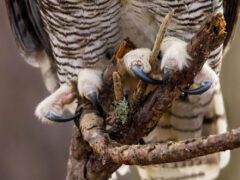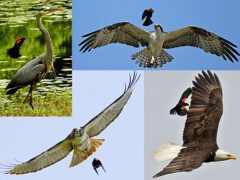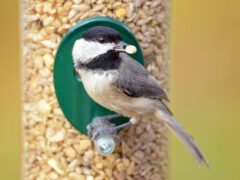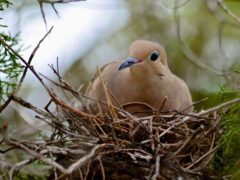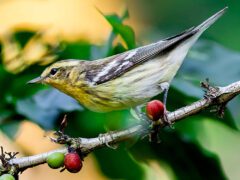Western Bluebird Similar Species Comparison
Main SpeciesWestern Bluebird
Adult male
Small stocky thrush with a thin bill and short tail. Usually perches upright. Males are shiny blue above with rust-orange extending from a vest on the breast onto the upper back. Note blue throat.
© Brooke Miller / Macaulay LibraryCalifornia, January 13, 2015Female/immature
Small stocky thrush. Some females are duller than others. Dull females are gray-buff with a pale orange wash on the breast and blue tints to the wings and tail.
© Scott Martin / Macaulay LibraryArizona, March 14, 2019Adult male
© Timothy Barksdale / Macaulay LibraryNew Mexico, December 01, 1997Juvenile
Juveniles look like females, but have spotting on the back and streaking on the breast.
© Jerry Ting / Macaulay LibraryCalifornia, June 14, 2018Female/immature
Small stocky thrush. Some females/immatures are brighter than others. Bright birds are brighter gray-blue above with a pale chestnut breast and whitish belly.
© Kai Frueh / Macaulay LibraryOregon, June 30, 2017Adult male
Round-bellied thrush with a small thin bill. Adult males have a rich rusty-orange vest that extends up over the wings onto the back. Note blue throat.
© Jerry Ting / Macaulay LibraryCalifornia, May 06, 2017Adult male
Stocky and round-bellied thrush. Adult males have a rusty-orange breast and flanks and a pale blue belly that grades to grayish white. Note blue throat.
© Logan Lalonde / Macaulay LibraryBritish Columbia, March 21, 2015Female/immature
Nests in holes in trees or nest boxes.
© Alex Lamoreaux / Macaulay LibraryMontana, August 12, 2017Habitat
Found in open woodlands, backyards, burned areas, and farmland.
© Jerry Elling / Macaulay LibraryArizona, June 11, 2016Similar SpeciesMountain Bluebird
Adult male
Male Mountain Bluebirds are lighter sky-blue above and below than Western Bluebirds. They also lack the Western's rusty belly.
© Joshua Covill / Macaulay LibraryMontana, April 09, 2017Similar SpeciesMountain Bluebird
Female/immature
Female/immature Mountain Bluebirds are paler overall than female/immature Western Bluebirds. Their breast is generally browner with less rusty coloring than Westerns.
© Joshua Covill / Macaulay LibraryMontana, April 09, 2017Similar SpeciesEastern Bluebird
Adult male
Eastern Bluebirds have only a small range overlap with Western Bluebirds. Male Eastern Bluebirds have rusty throat, whereas male Westerns have a blue throat.
© Alix d'Entremont / Macaulay LibraryNova Scotia, February 21, 2017Similar SpeciesEastern Bluebird
Adult female
Female Eastern Bluebirds have a rusty wash on the side of their neck and a white throat, whereas female Westerns have a grayish head without the rusty wash and a gray throat.
© Alix d'Entremont / Macaulay LibraryNova Scotia, February 21, 2017Similar SpeciesLazuli Bunting
Breeding male
Lazuli Buntings are smaller than Western Bluebirds, with a thick, seed-eating bill and prominent white wingbars unlike the thin-billed and plain-winged Western Bluebird.
© Alix d'Entremont / Macaulay LibraryBritish Columbia, May 28, 2017Similar SpeciesLazuli Bunting
Female/immature
Female/immature Lazuli Buntings have 2 wingbars and a thicker seed-eating bill than female Western Bluebirds, which have plain wings and a thin bill.
© Marlene Cashen / Macaulay LibraryWashington, August 20, 2017Similar SpeciesCalifornia Scrub-Jay
Adult/immature
Though blue, California Scrub-Jays are much larger, noisier birds with longer tails, and heavier bills than Western Bluebirds.
© Brian Sullivan / Macaulay LibraryCalifornia, October 02, 2011Similar SpeciesWoodhouse's Scrub-Jay
Adult/immature
Woodhouse's Scrub-Jays are much larger and noisier birds with longer tails, heavier bills than Western Bluebirds.
© Chris Wood / Macaulay LibraryColorado, April 06, 2009Similar SpeciesSteller's Jay
Adult (Coastal)
Steller's Jays are much larger and bolder than Western Bluebirds. They also have a longer tail and a black crest.
© Jeff Maw / Macaulay LibraryCalifornia, May 16, 2017Compare with Similar Species
Click on an image to compare
Species in This Family
Thrushes and Allies(Order: Passeriformes, Family: Turdidae)
More to Read
Don't miss a thing! Join our email list
The Cornell Lab will send you updates about birds,
birding, and opportunities to help bird conservation.
















